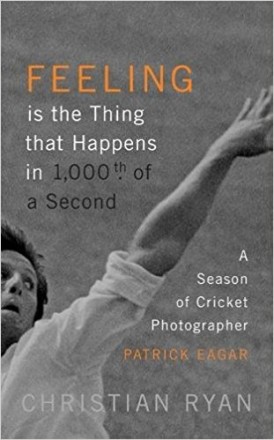Feeling is the thing that happens in 1000th of a second: a season of cricket photographer Patrick Eagar
Ken Piesse |Published: 2017
Pages: 256
Author: Ryan, Christian
Publisher: Riverrun/Hachette

For all its delightful myriads and laneways of opinion, cricket still has its indisputables. Best batsman? Bradman. Best bowler? Warne. Best broadcaster? Arlott. Best writer? Cardus.
And the most outstanding cricket photographer? Patrick Eagar, with daylight second.
From the time a teenage Eagar snapped West Indians Everton Weekes and Bruce Pairaudeau walking down the member’s steps at Northlands Road, Southampton in 1957, a career in photography beckoned.
In time, his passion, skill and sheer genius created a worldwide demand, his remarkable images being featured on the front pages of more newspapers, books and magazines than any other cricket photographer, dead or alive.
Timing was everything for the inquisitive, inspired, ever-ambitious son of a Hampshire great who was kicking around cricket grounds from the time he could walk.
His CV and body of work is simply stunning. Never satisfied, he always looking for variations and the results were often spectacular.
‘Eagar renders cricket such a service,’ said John Arlott, ‘as no one else in his field has ever done before.’
The first to set up a second unattended camera, normally at the opposite end of the ground, operated via a radio transmitter device, Eagar was able to take pictures front-on and from behind.
Always a freelancer, his work was first regularly published in The Cricketer magazine from 1965. So good was he that Agencies initially baulked at him having access. Old-timers were used to developing 16 or 17 pictures a day. Eagar at his peak was processing 175-180.
In a Test in 1976 with Michael Holding bowling to Tony Greig, he took 45 pictures of one ball with three different cameras.
Through his famous ‘Long Tom’ he became a master of light and lighting.
His first published cricket pictures had been taken secretly, from the back of the old Warner Stand at Lord’s in ’65. He wasn’t allowed anywhere near the fence with the regular snappers.
His period of pictorial dominance remains unrivalled. Geoff Boycott still regularly asks him for blow-ups of his 100th 100, which Eagar trades for golf balls, another of his sporting passions.
Eagar says his success was all about ‘feeling’ — taking the photo he wanted at the exact split-second.
His halcyon year was 1975 when he snapped the world famous side-on picture of Jeff Thomson at Lord’s on June 1. This photo is on the cover of Christian Ryan’s admirable new book, Feeling is the thing that happens in 1000th of a second: a season of cricket photographer Patrick Eagar.
Once he captured another Aussie fast bowler, an air-borne Alan Hurst in mid-air having just delivered. Hurst looked closely at the photograph and asked: ‘Is that really me?’
Eagar would do anything to test the accepted protocols of cricket photography, his use of radio wavelengths and different angles always adventurous and often inspired.
Much of the ‘interviewing’ for the book was conducted on Skype, Melbourne-based Ryan asking Eagar about his most special and satisfying photos from his stellar ’75 season studded by a World Cup and an Ashes series.
Forty-three of Eagar’s favourites make this collection, which is simply fascinating, especially for someone like me who worked with Patrick for years, publishing his photos in the Australian Cricketer and in many books.
While this is a book about cricket photography and one man’s passion and excellence in the pre-digital age, it is also riveting and absorbing for Ryan’s heady observations and inclusions, like when Weekes (subject of Eagar’s first photo) was once in the 290s in a game at Cambridge University. ‘C’mon Weekes man,’ he said to himself. ‘Play careful in the ‘90s. Careful man.’
I love this book. It’s different, inspired and one you won’t want to put down.


Leave a comment